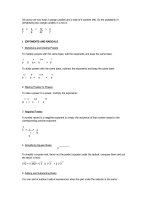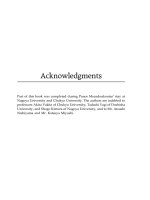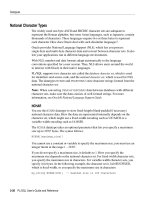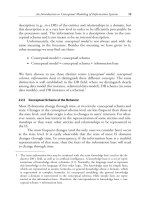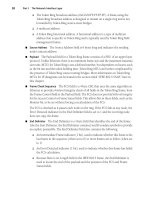systems of production markets organisations and performance phần 2 doc
Bạn đang xem bản rút gọn của tài liệu. Xem và tải ngay bản đầy đủ của tài liệu tại đây (803.15 KB, 12 trang )
Buenos Aires, Abril 2010
759
PRODUCTION SYSTEM
The goal of this ration is to give an extra shot of protein to the cows with about 100 grams of urea per day and to force
the ingestion of minerals in adequate quantity. In effect it is an "insurance" to protect the lactating herd from the risk
of a sudden down fall in protein levels or minerals, especially during the summer months. Thus the purchased feed ration
is not designed to substitute grass, as it is not profitable to replace grass with grain based feeds in most of Latin
American countries, and especially so in Venezuela.
CONCLUTION
With this feeding strategy Bufalinda achieves:
• An average stoking rate of 1,8 adult buffalo per ha, equivalent to about 3 steers per ha.
• Buffaloes are in excellent condition year round, and milk production remains in general unaffected by the dry season.
• Paddocks are protected from over grazing at the end of the dry season, as buffaloes are incrementally restricted of
direct grazing and more haylage under confinement is delivered.
Rotational Paddocks
There are two types of RP´s those with fixed lot area (RP with FLA) and those with variable lot area (RP´s with VLA).
RP´s with FLA are ideal for situations where the size of herd can be increased or decreased according to the supply of
forage. For example if a Lot of an RP with FLA has 120 fattening steers and it can only sustain 100 head for one day, then
the 20 head in excess are removed and sent elsewhere in order to avoid overgrazing and Cycle acceleration. So this type
of RP is suitable for non lactating herds.
On the other hand in lactating cows, herd count cannot be easily changed therefore the VLA RP´s are recommended. Thus
if we have a 200 cow herd that we need to feed for half a day (typically a twice a day rotation is used) then the farm hand
will determine and layout the precise lot area in order to accommodate and feed the 200 buffalo cows during half a day
without restrictions.
Design of FLA RP´s and VLA RP´s
Boundary fencing is shown with three lines, internal electric fencing is show in black with one line, moveable fencing for
dividing for front/back grazing of each lot are shown in red, and the rotational sequence is shown with blue arrows. This
FLA RP has 10 main lots which are divided into 20 with the moveable electric fence.
Other Considerations For The Design and
Construction of RP´s
1. A sturdy at least three wire perimeter fence
is required (middle line electric).
2. The central circulation street should be
no less than 20 meters wide, to guarantee
year round stress free transit to buffaloes.
3. The width of each Lot in a FLA RP should
be no more than 150 meters in order to make
it easy to change the portable fence, from
Lot to Lot.
4. The width of each band in a VLA RP should
be not wider than 200 meters for the same
reason mentioned above.
Proceedings 9
th
World Buffalo Congress
760
PRODUCTION SYSTEM
Other Considerations in RP Management
1. During times of rapid pasture growth Cycles
have to be accelerated and some paddocks left
behind for haylage production. Special care has
to be taken to avoid overgrowth and lignifica-
tion of the grass.
2. During times of slow growth herd size has to
be decreased or alternatively the herd can be re-
stricted of direct grazing while it is fed with hay-
lage. Special care should be taken to avoid Cycle
acceleration and overgrazing of the paddock.
• Distribución del rebaño en el pico de lactancia (enero a abril):
400 búfalas en ordeñe requieren 420 has (0,83 x 85%/80%) por lo tanto ocupan los 10 rotativos de bandas de 400
has y piden prestado algunas parcelas más cercanas a los rotativos fijos.
Alternatively if a farmer does not want to deal with the added labor and complications of VLA RP´s, the six paddocks
could be replaced by four FLA RP´s for a total of 8 identical FLA RP´s.
A Final Design
An ideal final design for a standard 500 ha milking unit would have six VLA RP´s for milking herds, one FLA RP for
surrogate mothers two for heifers and one for dry pregnant cows, for a total of 10 RP´s. The milking installations would
be located at the middle and the Surrogate Mother Barn at one side:
Buenos Aires, Abril 2010
761
PRODUCTION SYSTEM
Buffalo Production Systems in Argentina
Eng. Marco A. Zava
Executive Director - Argentine Buffaloes Breeders Association
Cap. Gral. Ramón Freire 183 - p. 2 - of. 40 - (1426) Buenos Aires - Argentina
Keywords: buffalo, production systems, subtropical area, Argentina.
ABSTRACT
An agricultural revolution started in Argentina in the last 30 years. A new generation of technologies produced a massive
expansion of the agricultural frontier, specially in the case of soybean. Cattle breeding has been displaced from a large
part of the humid pampas. An extraordinary cattle-breeding node is being developed in the Argentine northeast (NEA)
and more recently in the northwest (NOA) of the country. This scenario favored a great expansion of the buffalo, above
12 % per year. The NEA holds most of the buffalo heads. Of the 100,000 existing heads, the province of Formosa has
35,000 and Corrientes has 30,000. The buffalo production systems that we will describe are located in both provinces,
mostly in open low fields, with humid subtropical climate, north of 31° south latitude, with 1000-2500 mm. annual
rainfall, located in the Parana River basin, where cattle breeding is not very efficient. In the region, buffaloes occupy not
only the low lands but also the high fields, since under extensive conditions this allows for 20 % additional calving
compared to cattle, and 70-100 % additional weight gain, which results in slaughtering animals one year earlier. It
should also be highlighted that the buffalo cow productive life doubles that of cows.
The buffalo is becoming a fantastic tool for meat production in the subtropical regions of Argentina; and more recently,
since 1992, also for dairy production. The production datas described in this paper really are an objective to be reached
by the livestock industry in the country, specially in northern areas, possibly by means of buffaloes.
Proceedings 9
th
World Buffalo Congress
762
PRODUCTION SYSTEM
Buffalo's Grazing of Natural and Improved
Sward Pasturelands in Protected Environments
of Mediterranean European Union*
Martiniello1** P.; Annicchiarico1 G.; Caternolo1 G.; Sabia4 E.;Terzano2 G.M.; Odoardi3 M.;
Ursino3 A.; Pacelli4 C.; Mazzi2 M.
1CRA ZOE, Bella-Scalo; 2CRA PCM, Roma, 3CRA FLC, Lodi; 4University of Basilicata, Potenza.**Corresponding author: CRA ZOE,
S.S. per Napoli Km 12, 71100-Foggia (Italy) Tel. +390881880482; E-mail:
ABSTRACT
Herbage pasturelands production of 9 regions of Mediterranean European Union (EU) was weakened with drastic conse-
quences on animal feeding and geological stability of land. The effect of fertilizer applications on herbage was evaluated
by grazing with buffalo heifers and tested with a similar flock bred in cowshed. The determinations were carried out on
grass harvested in protected areas of sward. The fertilizer application increased 47% biomass yield, herbage quality and
small influence on flora composition and biochemical characteristic of topsoil. The mean heifers body gain was not
differed in buffaloes bred in intensive system using unifeed alimentation.
Keywords: fertilizers application, flora composition, herbage yield, pasturelands.
INTRODUCTION
The Italian protected pasturelands of Mediterranean European Union, (National Park, NP; Sites with Community Impor-
tance, SIS and Zones with Special Protection, ZPS), scattered over the territories amount about to 7.2 millions of
hectare. The biodiversity existing in these areas is protected by European law: 1,2 In the last decade, the agro-pastoral
activity stress the sward of the pastures with intensive grazing causing overgrazing of sward. The increase of soil of Ap
horizon with chemical applications favouring germination of the indigenous seedbank born present in the sward, devel-
opment of native flora, productivity and increasing biomass production and quality of the herbage of natural pasture-
lands. The experiments aimed to detect the effect of the increase in topsoil on flora composition, biomass and nutritive
value of herbage and biochemical composition of soil.
Buenos Aires, Abril 2010
763
PRODUCTION SYSTEM
RESULTS AND DISCUSSION
The effect of fertilizer not influence substantially the soil parameters content (Table 1).
Table 1: Biochemical characteristics of topsoil horizon (Ap35 cm) of the sward.
Table 2: Dry matter mean among phenological stage in natural and improved sward.
The non variation of soil organic matter between control and fertilizer treatment evidenced that the compounds required for
sustain the increase of dry matter production was achieved by microbial activity favoured the increase of soil fertility (Table 2):
3
The content of crude protein, MFU and fibre in grass of improved sward (12%, 6% and 4% higher than the control)
showed statistical significance in harvests (Table 3). The effect of fertilizer application on average increased the Gramin-
ea flora by 34% and 6% those of 29.5% in Legume. The presences of flora species belonged to Compositae.
MATERIALS AND METHODS
The experiments was established in two pasturelands sites of southern Italy in 2006-7 (Environment I, Gioi and Environ-
ment II, Monterotondo). 18 buffalo heifers of about 6 months hold begun to graze the sward and were removed 18
months later. Pasturelands of sites, in November of each year, were fertilised with combined nitrogen and phosphorous,
respectively at the rate 36 and 96 kg ha-1: 4. The characteristics of the herbages and soil were assessed in protected
surface of 2.25 m2 by iron fenced net boxes. The dynamics of grass growing and the intake of herbage browsed, was
determined by harvests of biomass present in the surface of 1 m-2, in side and outside of the iron box, at phenological
stage: herbaceous, harvest I (November), beginning of shooting, harvest II (March), heading harvest III (April), flower-
ing harvest IV (May) and dead plant harvest V (June), respectively for I, II, III, IV and V harvest. The flora species were
grouped into Graminaceae, Leguminousae and Compositae botanical families. All others were included in a miscellaneous
group. The data of the traits reported in the tables consider only the effect of improved treatment over sites. Compari-
sons among means were performed according to LSD statistical test at P=0.05 level of probability.
Proceedings 9
th
World Buffalo Congress
764
PRODUCTION SYSTEM
CONCLUSIONS
The effect of pasture improvement increased qualitative and dry matter characteristic in all harvests. The flora composi-
tion as affect of fertilizer shoved small variation of botanical species. Pasture improvement increase the availability of
herbage feeding, the morphological, physiological peculiarity of animal and the opportunity to safeguard soil erosion,
valorise ecological and nutritional aspects of natural pasture.
REFERENCES
1. Boitani L., Falcucci A., Maiorana L., Montemaggiori A. 2002. Rete ecologica Nazionale. Il ruolo delle aree protette nella conservazione dei
vertebrati. Ministero dell'Ambiente, 88 p.
2. Gazzetta Ufficiale. 1991. Legge quadro sulle aree protette. Gazzetta Ufficiale Supplemento Ordinario N. 83 alla G.U. n. 291, 1991.
3. Hill JO., Simpson RJ., Wood JT., Moore AD., Chapman DF. 2005. The phosphorous and nitrogen requirements of temperate pasture species and
their influence on grassland botanical composition. Australian Journal of Agricultural Research, 56: 1027-1039.
Table 3: Grass qualitative characteristic among harvests in natural and improved sward.
and Miscellaneous was 6% and 21%,respectively increased and reduced (Table 4).
Table 4: Effect of the improved treatments among the harvests on improved sward.
*G=Graminea, *L=Legume; *C=Compositae, *M= Miscellaneous.
As consequences of fertilizer application on flora species with high nutritive values the content of MFU was
5.7% higher than those of the control (Tables 3 and 4).
Buenos Aires, Abril 2010
765
PRODUCTION SYSTEM
Buffalos steers pos-weaning growth rearing on
natural pastures in the northwest of Corrientes
Rébak, G.I.1; Capellari, A.2 , Ynsaurralde Rivolta, E.A.3
(1) Prof. Tit. Tecnología de Alimentos. FCV - UNNE.
(2) Prof. Adj. Introducción a la Producción Animal FCV - UNNE. Sgto. Cabral 2139 - (3400) Corrientes.
(3) Becaria de pos-grado de SGCyT UNNE. e-maill:
ABSTRACT
The natural mating service in the fall, allows a perfect adaptation to the requirements of subtropical forage curve. The
buffalo do not need to go in heat waiting for the "flushing" of green grass that occurs during the spring. It suffices that the
summer temperatures are moderate, coming in heat from March to June, with fibrous grasses (there must be a minimum of
volume). This feature allows the production of buffalo milk and meat, not only in temperate zones, but also in the subtrop-
ics, with prudent management of loads in the winter: a buffalo on average represents 1.2 EV (cow equivalent). With respect
to the weight of these we note that at 18 to 20 months can reach 450 to 500kg, easily reached with a diet of grass to 600
kg at 24 months. The objective was to evaluate the production of buffalo meat kept in field under natural pastures from
weaning to shipment for slaughter. The trial was conducted in Ita Ibaté; General Paz Department of the Province of
Corrientes. Main activity is cattle and meat buffaloes with 1600 ha of downfield for the buffaloes production. The animals
used were buffalos steers crosses. The animals come from an extensive system of service fall, autumn calving and weaning of
spring. Feeding the animals were subjected to continuous grazing field was natural and the health plan used was recom-
mended for cattle. Measurements in animals were: body weight, hip height at the initial and final gasping. Meat production
in field under natural pastures for cattle disabled is a very important production alternative for the region.
Keywords: buffalo meat, fattening, rearing, natural pasture
INTRODUCTION
In our country there are areas for buffalo unexploited or inefficiently exploited, are low and flooded land (60,000 ha), including
low submeridional of the province of Santa Fe, Corrientes Esteros del Ibera in the coastal lowlands of the Rio Parana and Uruguay
in Formosa , Chaco and Corrientes, the pre-delta in the province of Entre Rios and the Delta of the province of Buenos Aires 2.
Corrientes, has a network consisting of wetland marshes, reservoirs, marshes, and ponds malezales, covering an area of about
16,000 km2. A dominant feature of the relief is to integrate a sedimentary basin with poor drainage, which determines the
presence of vast areas flooded and flooding, it is estimated that both cover 45% of the provincial surface (flooded 17% and flood-
prone 28%) 3. The buffalo production systems are mainly extensive, natural pastures humid subtropical climate, mainly in the
northeast of the Argentinian. The calving rate varies between 80 and 98% (well above 60 - 70% of cattle). To calculate the loads
are considered in their requirements a buffalo cows is equivalent to 1.3, because its weight is greater in some 150 kilos. The
production per hectare per year ranging from 40 to 60 kilos, while the cattle does not exceed 40 kilos. The daily gain is remarkable:
700 grams / day pre - weaning and 500 grs. / day post - weaning (70 to 100% higher than cattle under the same conditions). This
allows the slaught at 27 to 30 months of age, with a live weight of 500 - 550 kilos and a yield of 50 to 55% 8. The trail objective
was to evaluate the production of buffalo meat in natural pastures from weaning to slaughter weight.
Proceedings 9
th
World Buffalo Congress
766
PRODUCTION SYSTEM
MATERIAL AND METHODS
The trial was conducted in Ita Ibaté, Department of General Paz in the province of Corrientes. The main activities include
cattle and meat buffaloes with 1600 ha of downfield for the buffalo production. Set in Depression Ibera known subunits:
2a. Ibera Marshes: swampy region dotted with lakes that decrease to the south and is an ecological environment with
very few analogies in the world. Is dominated by marsh vegetation, partly floating, and from which emerge some islands
scattered arboreal vegetation (ZAH II) 3. The animals used were buffalos steers crosses. Come from an extensive farming
system of continuous service in autumn and weaning of spring. Feeding the animals were subjected to continuous
grazing field was under natural pastures and the health plan used was recommended for cattle. Measurements in animals
were: body weight, hip height at the initial and final gasping. For live weight and the height is used a single scale and
a tape measure, respectively, and the gasping for determining the timing tooth was performed when each animal was
immobilized in the stocks of the box to operate. The data sheets were settled in the farm and then were statistically
analyzed by the Info-Stat program version 2009 for Windows by the technique of frequency distribution of simple series.
RESULTS AND DISCUSSION
The results are reported in Tables 1 and 2.
Table 1: Number (n), average, standard deviation (SD), minimum and maximum weaning weight, hip height at weaning
and final weight of steers buffalos crosses, in Ita Ibaté, Corrientes.
The total gain achieved by the buffalo in 379-day evaluation of 159.18 kg in low fields of natural pastures were higher
compared with the 50 to 86 kg of meat per hectare per year is commonly achieved in the farms of Corrientes with natural
pastures beef cattle 7. The growth pattern for growing cattle, using natural field fodder only recourse is very similar to the
growth curve of this range. There are eight months of weight gain of 500 g/day/animal and four months on weight
maintenance during the winter. The annual weight gain for growing cattle range from 70 to 80 kg in Malezales, 90 to 120
kg in Lomadas Sandy, from 125 to 160 kg in South Central and 95 to 105 kg in the Northwest 4,5. Measurements of annual
weight gain of animals on natural pastures for growing a load of 1 head/ha in the area of agro-ZAH homogeneous flows II,
resulted in annual production of meat for the north 80 to 100 kg LW/ha, rather trial and to the south of 145 kg LW/ha
3
.
Table 2: Frequency table of the final weight of buffalo steers at 20 months of age produced in natural pastures in Ita
Ibaté, Corrientes.
Buenos Aires, Abril 2010
767
PRODUCTION SYSTEM
REFERENCES
1. Arias, A.; Manunta, O. y A., Slobodzian. 1991. El mejoramiento genético de los bovinos de carne en la Provincia de Corrientes. Ed. INTA. Serie
Producción Animal. Bol Técnico N°5. Corrientes, Argentina. 62p.
2. Benítez, D. 2006. Características productivas del búfalo en Argentina. Ed. INTA. Noticias y Comentarios. Abril de 2006 Nº 408. Mercedes,
Corrientes. Argentina. 4.p.
3. Calvi, M. y Acosta, F. 2005. Provincia de Corrientes: Zonas Agroeconomicas Homogéneas. Serie Técnica Nº 36. EEA INTA Mercedes. Corrientes,
Argentina. 45p.
4. Pizzio, R.M.; Royo Pallares, O.; Delfino, D.; Arias Usandivaras, F.; Kraemer, S. 2000. Producción animal en seis pastizales del este de la provincia
de Corrientes. Noticias y Comentarios Nº 344. EEA INTA Mercedes.
5. Royo Pallares, O.; Goldfarb, C. 1999. Experiencias con pasturas subtropicales cultivadas en la Provincia de Corrientes. Simposio Internacional
de Forrajeras Subtropicales. Facultad de Agronomía y Zootecnia, Universidad Nacional de Tucumán.
6. Sampedro, D.; Vogel, O. y A. y R. Celcer. 2004. Suplementación de vacunos en pastizales naturales. Ed. INTA. EEA Mercedes. Serie Técnica N°34.
Corrientes, Argentina. 25p.
7. Vallejos, G.A.; Conti, M.; Manunta, O.A. y A. A., Arias. 1979. Evaluación bajo pastoreo de pasto pangola en exarroceras. Ed. INTA. Serie
Producción Animal. Bol Técnico N°3. Corrientes, Argentina. 26p.
8. Zava, M. 2007. El nuevo rol del búfalo en la ganadería en el NEA (sistemas de producción de búfalos en Argentina). Memorias del 1er Seminario
de NEA. Corrientes, Argentina.
45% of the buffaloes had a final weight of between 290 and 360 kg of live weight, 43% weighing between 360 and 420
kg of live weight and 12% between 420 kg and 500 kg liveweight the second summer of their life or after the first winter
unlike steers whose completion in our province performed mostly on natural pastures and the animals are marketed at 500
kg at 4-5 years of age. This represents a gain of 70 to 90 kg/animal/year 6.
Meat production in natural pasture often unusable for cattle production is an important alternative for buffalo produc-
tion in the region.
Acknowledgments. Especially the professional technical staff, company directory, personnel of the farm and all who
accompanied, enable and allowed for these and so many tasks, essential to the progress of a country like ours, based
economically in production of primary products.
Proceedings 9
th
World Buffalo Congress
768
PRODUCTION SYSTEM
Characterization of Buffalo Management on
Dairy Farms in the State of Pernambuco, Brazil*
Dos Santos, K.L.1; Modesto, E.C.2; Vieira Batista, A.M.3; Marcelo José Da Silva, F.B4
1-Aluna do Programa de Doutorado Integrado em Zootecnia, bolsista do CNPq. Universidade Federal Rural de Pernambuco, UFRPE. Av. Dom Manoel de Medeiros, s/n, Dois Irmãos, Recife-PE, Brasil.
2-Professora do Departamento de Zoote cnia, Universidade Federal Rural do Rio de Janeiro. Rodovia BR 465, km 07 s/n Seropedica, RJ - Brasil. 3- Professora Adjunta, Departamento de
Zootecnia, bolsista de Produtividade em Pesquisa do CNPq. Universidade Federal Rural de Pernambuco, UFRPE. Av. Dom Manoel de Medeiros, s/n, Dois Irmãos, Recife -PE, Brasil 4-Aluno do
programa de p ós-graduação em Zootecnia. Universidade Federal Rural de Pernambuco, UFRPE. Av. Dom Manoel de Medeiros, s/n, Dois Irmãos, Recife -PE, Brasil. E-mail:
ABSTRACT
The objective was to identify and characterize the producers of buffalo milk in the state of Pernambuco. The farms were
located with help from the Builders Association of Buffalo and Defense Agency and Supervisory Agricultural State of
Pernambuco. The study was conducted in eighteen different farms from January to October 2009, but only six of them
explored buffalo milk. Farmers were handed with a questionnaire with the purpose of gathering data on their farms. The
questions addressed infrastructural and technological management aspects. Infrastructural issues were centered at iden-
tifying the farm's location, its average land area and access roads. As for the technological management, its goal was to
define which technical resources being used for reproductive management, feed management and milking management.
The data obtained from the questionnaire were subjected to frequency analysis so to identify common points. From the
inspected farms, 50% were greater than 100 hectares, 42.82% had fewer than 50 cows, pasture with dry roughage supp
lamentation represented 66.66% of intake food, 71.43% held natural breeding, and in 57.14% of them the milking was
conducted manually with calf at foot. Mostly, the buffalo milk producers in Pernambuco use low-cost system with low
technology adoption.
Keywords: Production System, milk production and technological management.
INTRODUCTION
Buffalo herds in Brazil total approximately 1.31 million heads, among which 19,239 are raised in the state of Pernambu-
co.
1
Buffalos were introduced in the state in the early 1970s, due likely to the sugar-alcohol crisis that drove the creation
of this industry, as buffalos occupy lands that are improper for sugarcane plantations and cattle raising. The buffalo has
adapted well to the environmental conditions of the region.
2
Studies on buffalo production systems in Pernambuco are scarce. A survey in the Zona da Mata of state was carried out
in 1998, which found deficiencies in the general management of the herds, as expressed by the low use of technologies
despite the integration of buffalo raising and the sugar-alcohol industry.2 Information generated from reliable data and
related to milk production systems, regional particularities and common market demands is a valuable tool for decision-
making processes and more efficient production on buffalo farms.
3
The aim of the present study was to characterize the dairy buffalo industry in the state of Pernambuco, Brazil.
Buenos Aires, Abril 2010
769
PRODUCTION SYSTEM
MATERIALS AND METHODS
A survey of buffalo milk production units in Pernambuco was carried out between January and October 2009. Eighteen
farms were visited, only seven of which were dairy farms. The properties were located in the municipalities of Vitória de
Santo Antão, Ribeirão, Água Preta, Quipapá, Sairé and Canhotinho, which pertain to the wet coastal and semi-arid
hinterland regions of the state of Pernambuco (Brazil). The farms were located with the assistance of the Association of
Buffalo Raisers and the State of Pernambuco Livestock Defense and Monitory Agency. Despite the help of these organiza-
tions, there is no information on the actual number of buffalo dairy farms and there is a lack of stimulus on the part of
producers to form associations. The official record of the 2006 Livestock Census reports 11 buffalo dairy farms.
4
A semi-structured questionnaire with both open-ended and closed-ended questions was used for the characterization of
the farms with regard to infrastructure and technological management. In relation to infrastructure, location, area of the
property and access to the farm were investigated. Concerning technological management, technical reproductive man-
agement resources, feeding management and milking management were investigated. The data obtained were submitted
to frequency analysis for the identification of the most common points.
RESULTS AND DISCUSSION
Dairy buffalo farming represents 33.32% of the buffalo exploitation in the state of Pernambuco (Figure. 1), half of these
dairy farms are located in the wet coastal region and half in the semi-arid hinterland of the state. This value is above the
national average of 15% for milk production and 85% for meat production.
5
The predominant breed in the production systems is Murrah. This breed is an excellent milk animal, with production
between 1500 and 4000 liters in an average of 300 days of lactation.6 The number of matrices varied with the property
size, with a greater percentage (42.86%) for properties with less than 50 matrices, whereas 50% of the farms were larger
than 100 hectares (Table 1). A total of 71.42% of the farms have areas with a river and/or ponds. The average distance
from town is 11.16 km, which facilitates the commercialization of the products.
In general, buffalo milk is not the exclusive source of
income of the producers. Among the producers inter-
viewed, 57.15% carry out other activities: 28.57% raise
buffalo and cattle; 14.29% raise buffalo, cattle and
sheep; and 14.29% raise buffalo and cattle and produce
sugarcane.
Figure 1: Principal types of buffalo production
systems in the state of Pernambuco, Brazil.
Table 1: Characterization of production systems on buffalo
dairy farms in the state of Pernambuco, Brazil
Proceedings 9
th
World Buffalo Congress
770
PRODUCTION SYSTEM
Age is used as a requisite for the first mating of the females on 85.71% of the farms. First mating occurs prior to 24
months on 16.66% of the farms, at 24 months on 66.66% of the farms and at 36 months of age on 16.66% of the farms.
Mounting is natural on 71.43% of the farms. Only 28.57% make us of artificial insemination and/or estrous synchroni-
zation. This is likely due to the fact that these methods require a greater degree of organization on the part of the
producer. The pasture feeding system is employed, formed by species from the genera Braquiaria and Pangola. On 66.67%
of the farms, grazing is rotative, with grass/legume supplementation in the dry season. Only 33.33% of the farms use
some type of grain/seed supplementation.
Milking is manual on 57.14% of the farms and performed once a day (in the morning) on 85.71% of the farms surveyed.
The presence of the calf is also obligatory to stimulate the release of the milk. Practices such as washing the teat and pre-
dipping are performed on 57.14 and 42.82% of the farms, respectively. Post-dipping is not performed on any of the farms
surveyed and less than 50% use tests for the detection of mastitis (strip cup test and California Mastitis Test).
Buffalo milk production in the state of Pernambuco occurs on large, medium-sized and small farms. The predominant
production system employs grazing, with low use of technology. Deficiencies in feeding management and milking hy-
giene were observed.
REFERENCES
1- Instituto Brasileiro de Geografia e Estatística (IBGE). 2008. Produção Pecuária Municipal 2007. v. 35, p.1-62.
2- Fernandes, S. A. A.; Lopes, G.M.B.; Panizza, J.C. J.; Matarazzo, S.V. 2008. Sistemas produtivos de búfalos na zona canavieira de Pernambuco,
caracterização e diagnóstico. Rev. Bras. de Saúde Produção, v.9, n.3, p. 565-577.
3- Lopes, A.D. 2008. Caracterização de unidades produtoras de leite na área de abrangência do escritório de desenvolvimento rural de Jaboticabal.
Dissertação mestrado, Faculdade de Ciências Agrárias e Veterinárias, Unesp, Campus de Jaboticabal, p.97.
4- Instituto Brasileiro de Geografia e Estatística (IBGE). 2006. Censo Agropecuário 2006. http:// www.ibge.gov.br/home/estatistica/economia/
agropecuaria/censoagro/2006/agropecuario.pdf.
5- Mariante, A.S.; Mcmanus, C.; Mendonça, J.F. 2003. Country report on the state of animal genetic resources. Documentos Embrapa Nº 99,
Brasília, p.121.
6- Rosa, A. M.; Filho, D. Z.; Martins, I.S. 2007. Introdução de búfalos no Brasil e sua aptidão leiteira. Rev. Científica Eletrônica de Medicina
Veterinária, ano IV, n.08.



